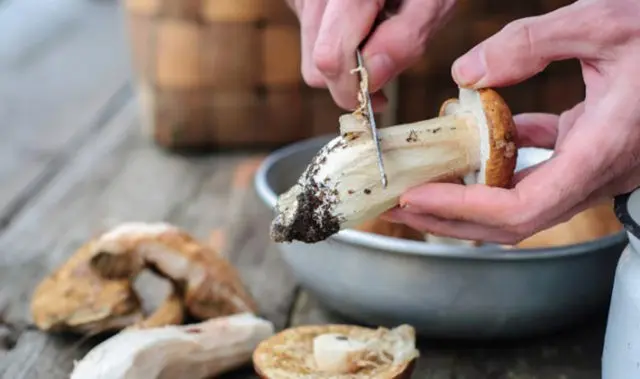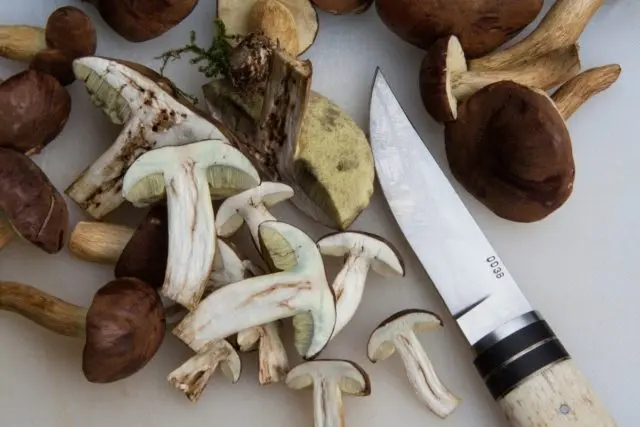Contents
Experienced mushroom pickers do not recommend cleaning porcini mushrooms. It is enough to remove dirt, adhering grass and foliage from the skin. Partial cleaning is performed if the crop was harvested by a barbaric method, or in the presence of obvious damage.
Do I need to peel porcini mushrooms
Mushroom pickers consider the white species to be noble. It is not necessary to remove the skin from it, remove the spore-bearing layer, film under the hat. There is no need to even clean the white leg. In such gifts of the forest, everything is edible and nothing contains bitterness. In general terms, cleaning porcini mushrooms involves removing adhering grass, foliage, and dust. This can be done by wiping the surface with a soft brush.
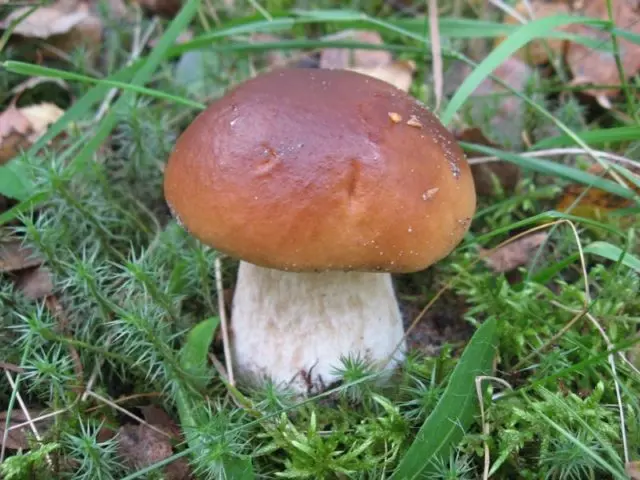
White specimens are considered clean and do not require additional cleaning.
Real mushroom pickers harvest correctly. The leg is cut off with a knife near the ground. After such an assembly, the white gifts of the forest are perfectly clean. It is enough to rinse them with water before cooking. However, there are people who harvest in a barbaric way, pulling fruit bodies out of the ground with their hands. With this method, together with the leg, a part of the mycelium is pulled out with the ground. These are the ones that need to be cleaned up. With a knife you need to cut off the ends of the dirty legs.
The downside of barbaric harvesting is not only the destruction of the mycelium, but also extra work for the mushroom picker himself. White specimens folded into a basket are smeared on dirty legs. The crumbling remains of the soil from the mycelium fall under the caps, stick to the body. At home, such mushrooms will have to be washed very carefully to get rid of the sand.
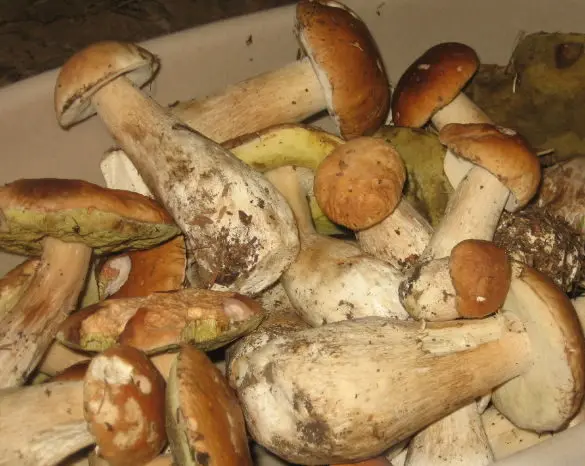
The main contamination of the collected mushrooms is sticky grass on the legs.
How to clean porcini mushrooms before cooking
For each method of cooking porcini mushrooms, there are nuances of preparing the harvested crop. However, regardless of this, the main method of cleaning is one, and it must be performed in compliance with a number of rules:
- It is important for a novice mushroom picker to learn the basic rule – you need to process porcini mushrooms immediately after picking. Despite the dense pulp, the process of its decomposition occurs according to one pattern inherent in all species. After harvesting, the mushroom picker has time from 3 to 5 hours to take a break and carry out cleaning without loss.
- With a knife from the pulp, it is reasonable to scrape off only the affected areas and heavily ingrained dirt. It is more effective to wipe the entire surface from light contamination with a rag or a small brush with soft bristles.

- Strong dirt is scraped off with a knife and the lower part of the leg is cut off if it was torn out of the mycelium
- Cleaning always begins with the removal of large debris. It is better to perform this procedure even in the forest, so that the harvested crop is less polluted in the basket.
- Further primary processing of porcini mushrooms combines washing in water and final cleaning. First, the crop is simply washed. The next step is to soak it optimally in salted water for a maximum of 15 minutes. During this time, adhering insects, blades of grass, dust will get wet from the surface of the fruiting bodies. Soaking is more helpful in getting rid of the grit that can squeak uncomfortably on the teeth in the finished product.
The fruiting body has the ability to strongly absorb water. The pulp becomes loose, brittle, loses its taste and useful substances.
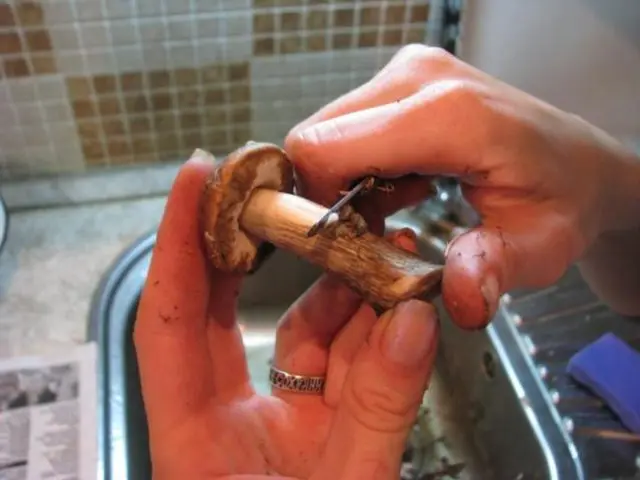
If during washing problem areas are found on the surface of the white fruiting body, they must be cleaned with a knife
After soaking and the first washing of the crop, you will have to take the knife again. Now is the time to partially clean the legs of ceps, in areas with visible damage. After washing, they are well manifested by darkened spots. Cut off the pulp with holes left by the worms. Usually such areas are found below at the base of the leg.
After cleaning, you need to wipe the entire surface of the porcini mushroom with your hand. If peeling of the skin has occurred, this indicates its depravity. Such a skin and even part of the pulp is removed without regret.
After repeated cleaning, the mushrooms are quickly washed under a strong stream of cold water, loaded into a colander to drain.
In the video, an example of an easy way to clean forest mushrooms:
How to clean porcini mushrooms before frying
One of the most popular and favorite dishes of all mushroom pickers is fried porcini mushrooms. After cooking, their flesh takes on the appearance of white meat. Preparation for frying takes place according to generally accepted rules:
- Harvested at home is cleaned with a knife blade from large debris. Usually it is enough to scrape off strongly adhered grass, ingrained dirt, cut off the bottom of the damaged leg.
- After the initial cleaning, the mushrooms are immersed in water. If the crop was harvested in the forest in dry weather, you can immediately start washing. When harvested after rain or in sandy areas, after cleaning, the crop is soaked in salted water for 15 minutes. During this time, dirt will separate from them. However, the main thing is that soaking will help clean the porcini mushrooms from sand – the most unpleasant and hard-to-remove pollutant.

Cutting porcini mushrooms into two parts helps to identify wormy specimens
- After the initial treatment, the fruiting bodies are washed under running water, loaded into a colander. While they are draining, the darkened and damaged areas of the pulp are cut off with a knife. Remove everything that flakes off. For frying, it is optimal to cut each mushroom lengthwise into two parts. The procedure will help identify wormy specimens. In addition, the halves are better fried.
After cutting, porcini mushrooms are again put in a colander, doused with boiling water, left to drain. When water stops dripping from them, it is advisable to dry the mushrooms slightly in the air. Now they are ready to fry.
How to clean porcini mushrooms before freezing
The processing of porcini mushrooms after harvesting for freezing occurs a little differently. All cleaning actions take place in a similar sequence, only contact with water is unacceptable. Since the white pulp absorbs moisture well, after freezing and thawing, it will become unsuitable for food. Washing is replaced by wiping the surface of each porcini mushroom with a damp cloth. From light moistening, the pulp will not be saturated with moisture, and dry dirt will slightly get wet.
After wiping with a rag, start cleaning. Soaked large particles are cleaned with a knife. Even if the leg was carefully cut from the mycelium with a knife, the cut is updated. Cut off wormy, rotten and darkened areas. If necessary, the surface of the mushroom can be scraped again with a knife blade. Finish cleaning with another wipe with a damp cloth. Ready mushrooms are cut with a knife lengthwise into two halves. Instances with discovered moves of worms are thrown away. Good white specimens are placed in plastic boxes or plastic bags and sent to the freezer.
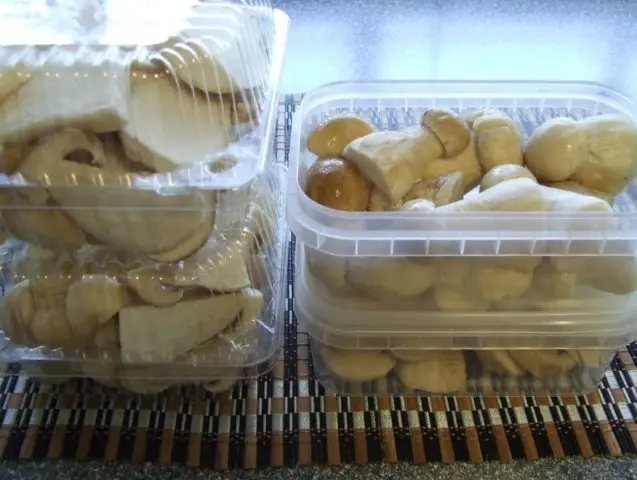
Frozen mushrooms are best stored in plastic boxes.
How to clean white mushroom before cooking
White young mushrooms are delicious in soups and other dishes that require cooking forest dwellers. Preparation is practically no different from the actions taken before frying. A big plus is the ratio of white mushrooms to the highest category. They do not require pre-cooking. After all the stages of cleaning, it is enough to pour boiling water over the white fruiting bodies. There is no need to leave them for a long time in a colander to drain and dry in the air, as they will boil in water anyway.
How to clean porcini mushrooms before canning
There are many different recipes for preserving white forest products. Often they do not provide for cooking. In addition to cleaning, it is important to pay attention to thorough washing. The process similarly begins with the removal of adhering debris. The surface is cleaned with a soft brush. The wiped bodies are sent for soaking. Here it is important to properly prepare porcini mushrooms for conservation. Soaking lasts up to 20 minutes, but the water needs to be changed several times. In addition, in addition to salt, vinegar or citric acid powder is added. Action helps achieve two goals:
- Salt with acid enhances the crispy properties of white pulp, which is especially appreciated in canned or pickled specimens.
- Most recipes do not call for boiling white fruit bodies before preservation. Salt and acid destroy bacteria that may not die during cold salting.
After soaking, all fruit white bodies are subjected to a final cleaning. Cut off damaged areas with a knife. Each is cut into two halves, inspected. Good specimens are sent for conservation.
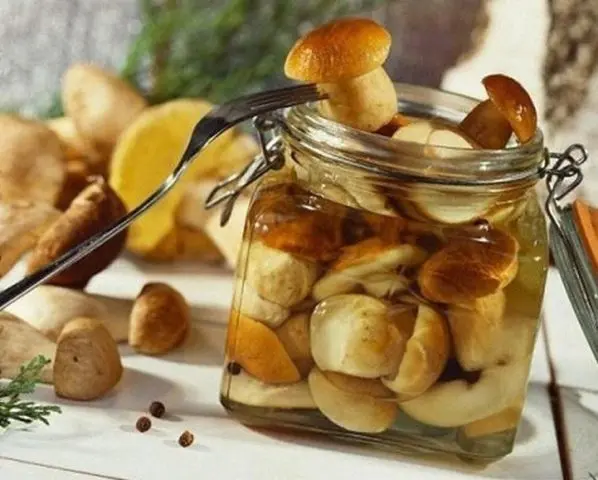
Young fruiting bodies are better suited for preservation.
How to wash white mushrooms
You can’t do without washing forest fruit bodies. Crunchy sand on the teeth will make any dish inedible. If harvesting was carried out in sandy areas or after rain, washing is best done under a constant stream of cold running water. A ten-minute procedure will not cause any harm.
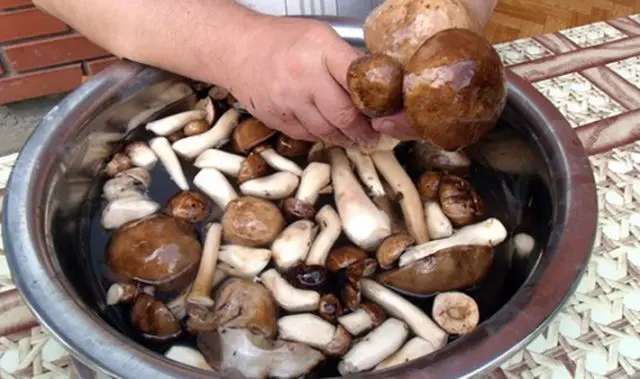
Be sure to wash fruit bodies before cooking.
After the first washing, the pulp of good fruiting bodies will not have time to be saturated with water. If, when touched by hand, the fungus falls apart, loose, emits droplets of moisture, then it is better to throw it away. The test result helps to identify old species that are unsuitable for food. During cooking, toxic substances can form inside such pulp.
The last step in washing is soaking. If further processing of porcini mushrooms involves heat treatment, then one salt can be added to the water. When cold salting is envisaged, acid is needed to kill bacteria. Vinegar, citric acid are added to the water, you can squeeze a lemon. After soaking, the fruiting bodies are washed under running water.
Conclusion
Cleaning porcini mushrooms and washing them before cooking is easy. It is important to be careful and get rid of wormy specimens. If you carefully collect young fruiting bodies, then there are practically no worries with them.










